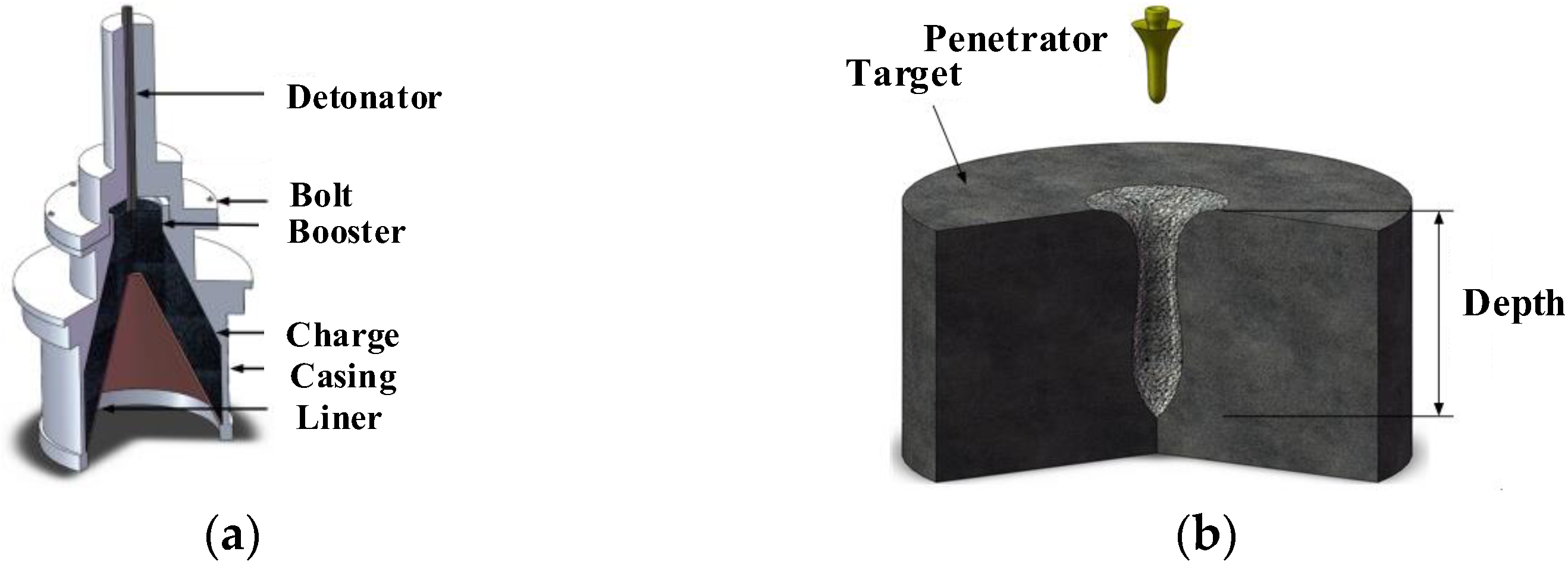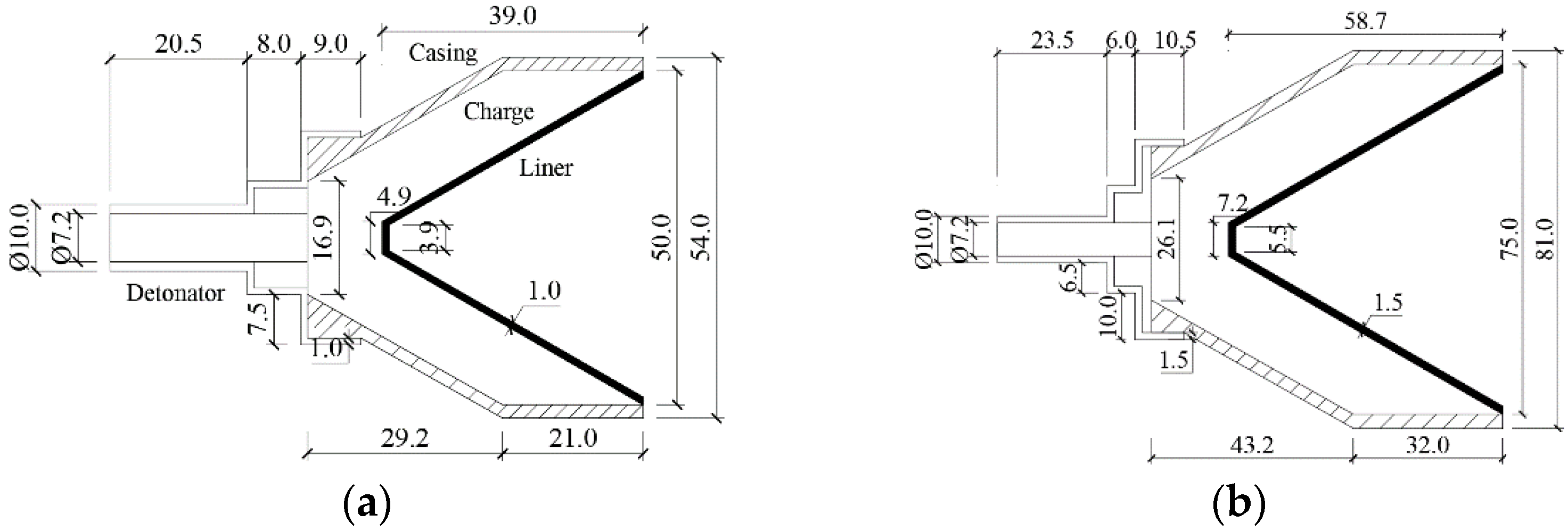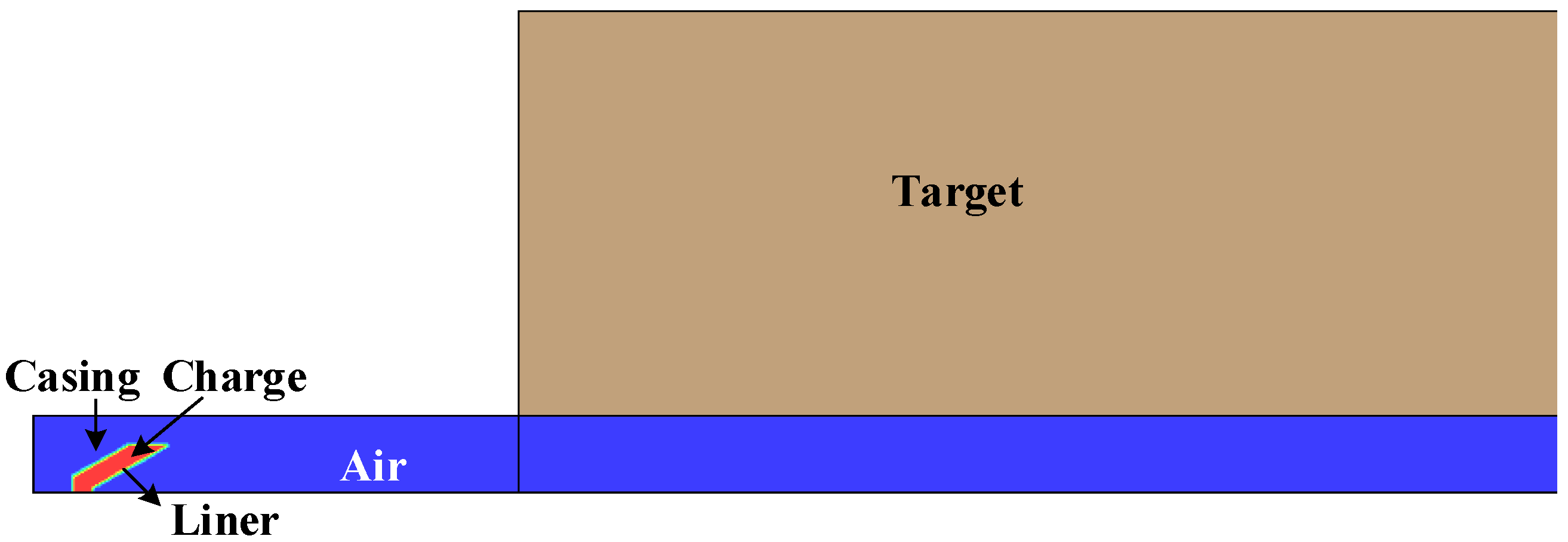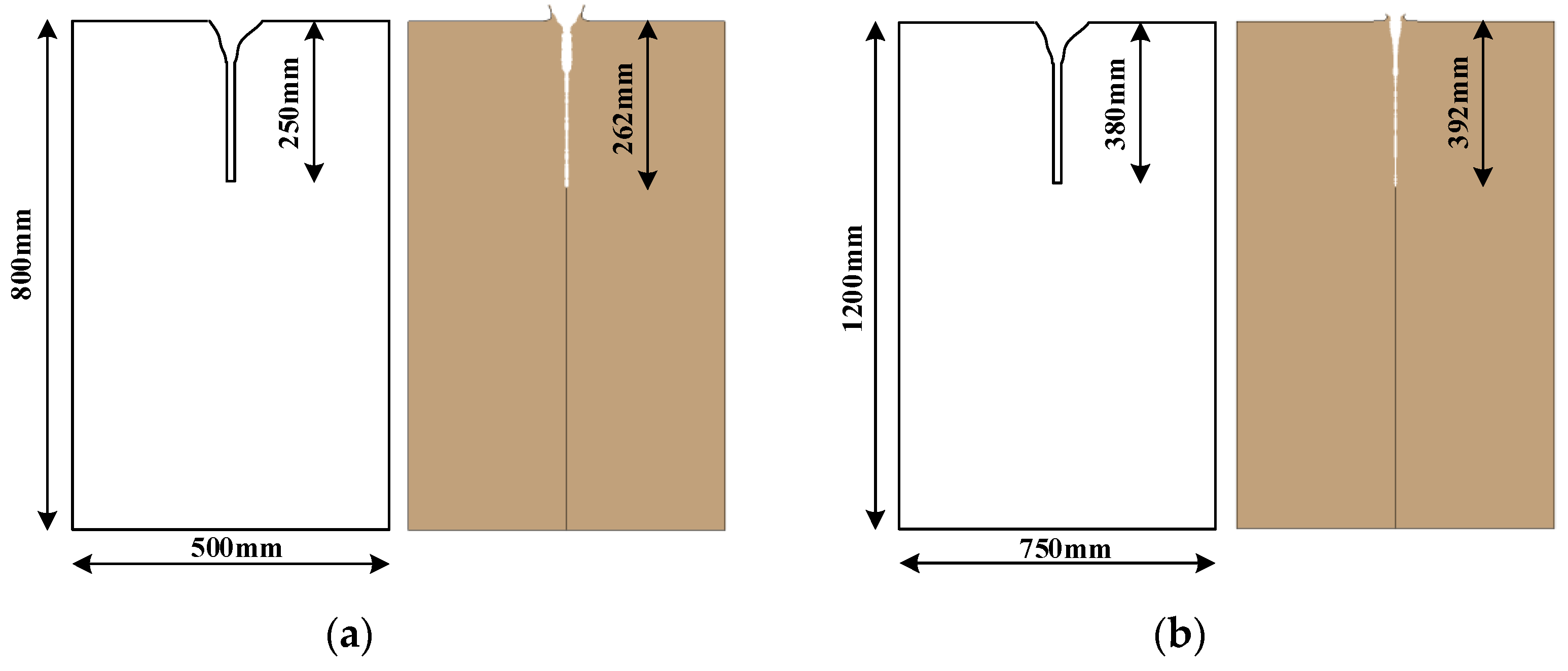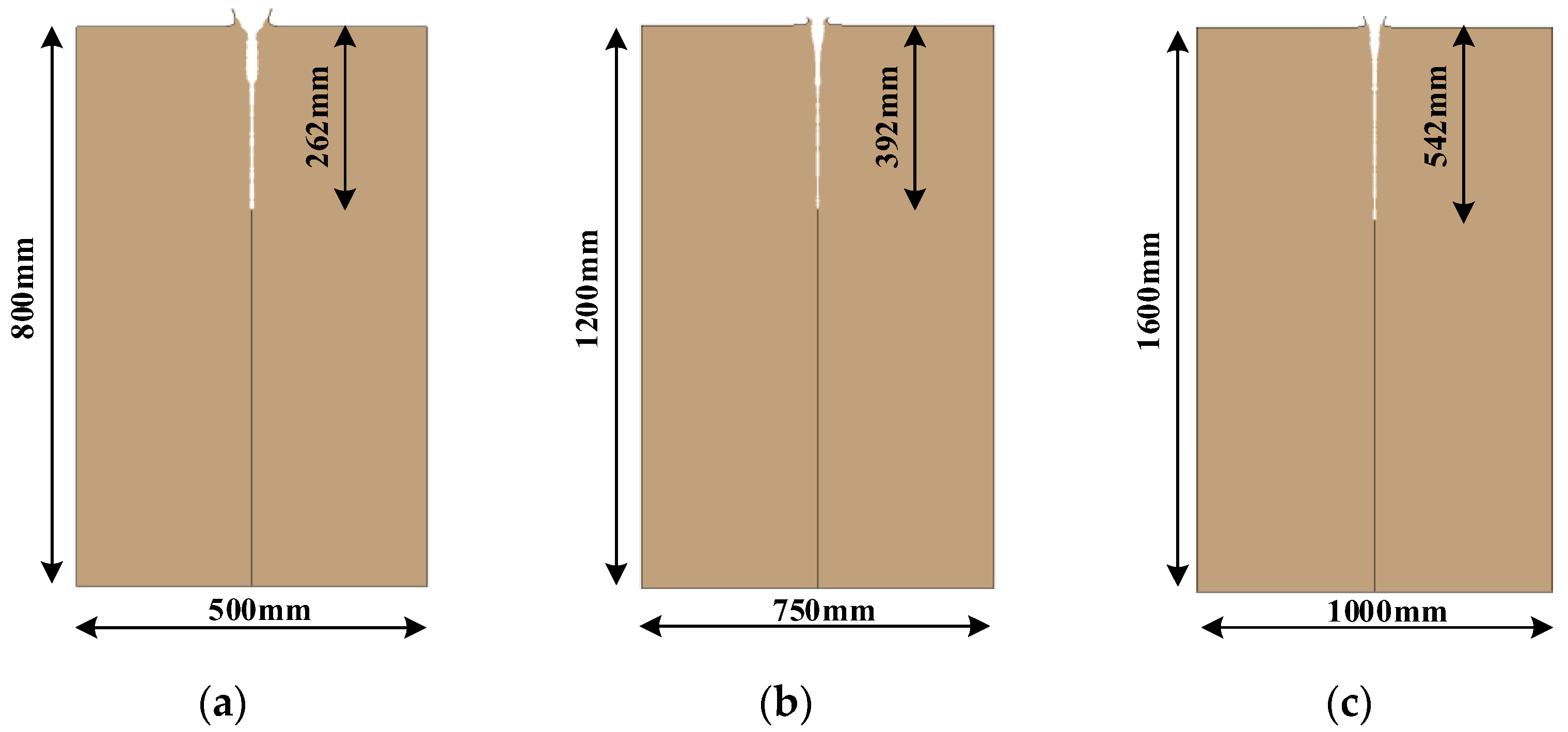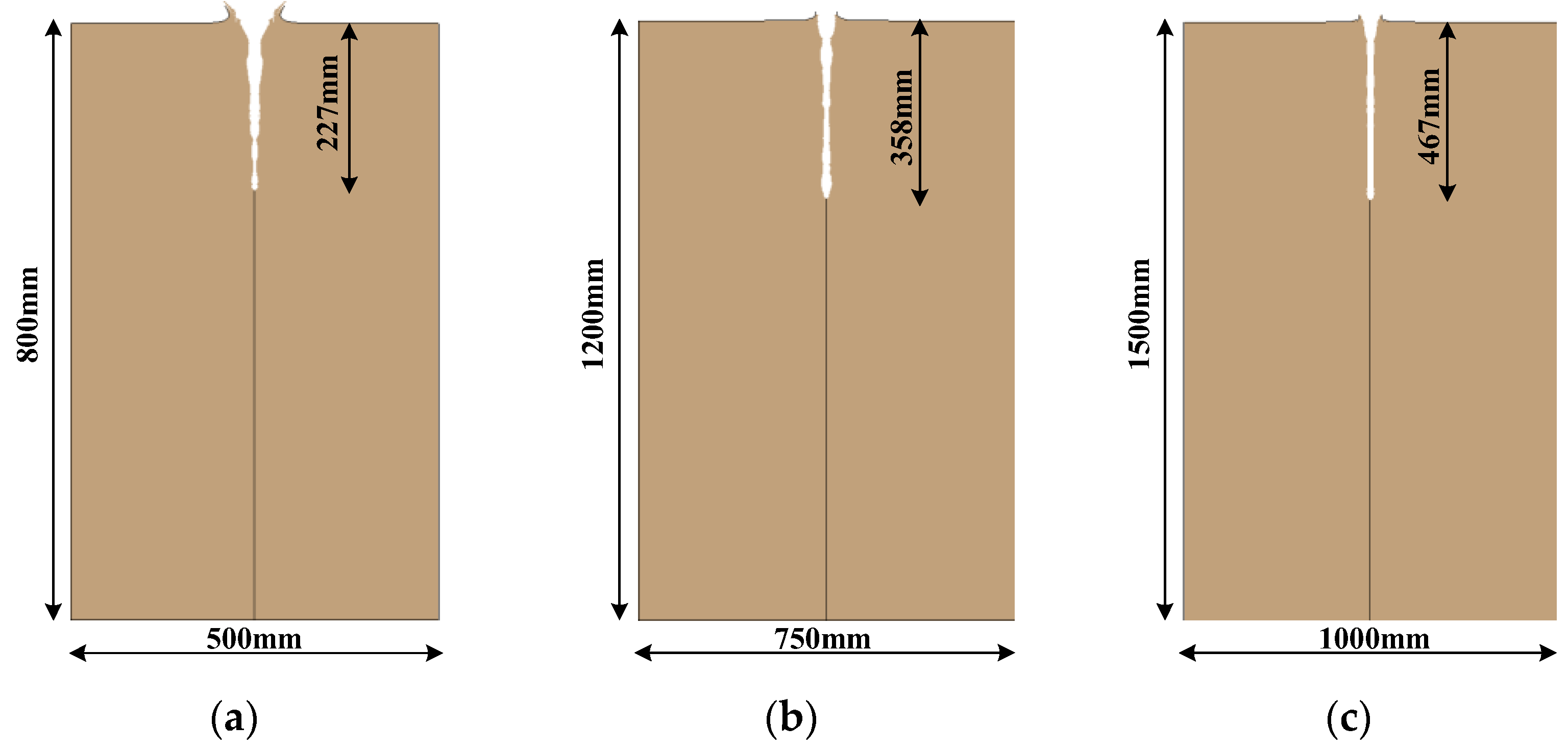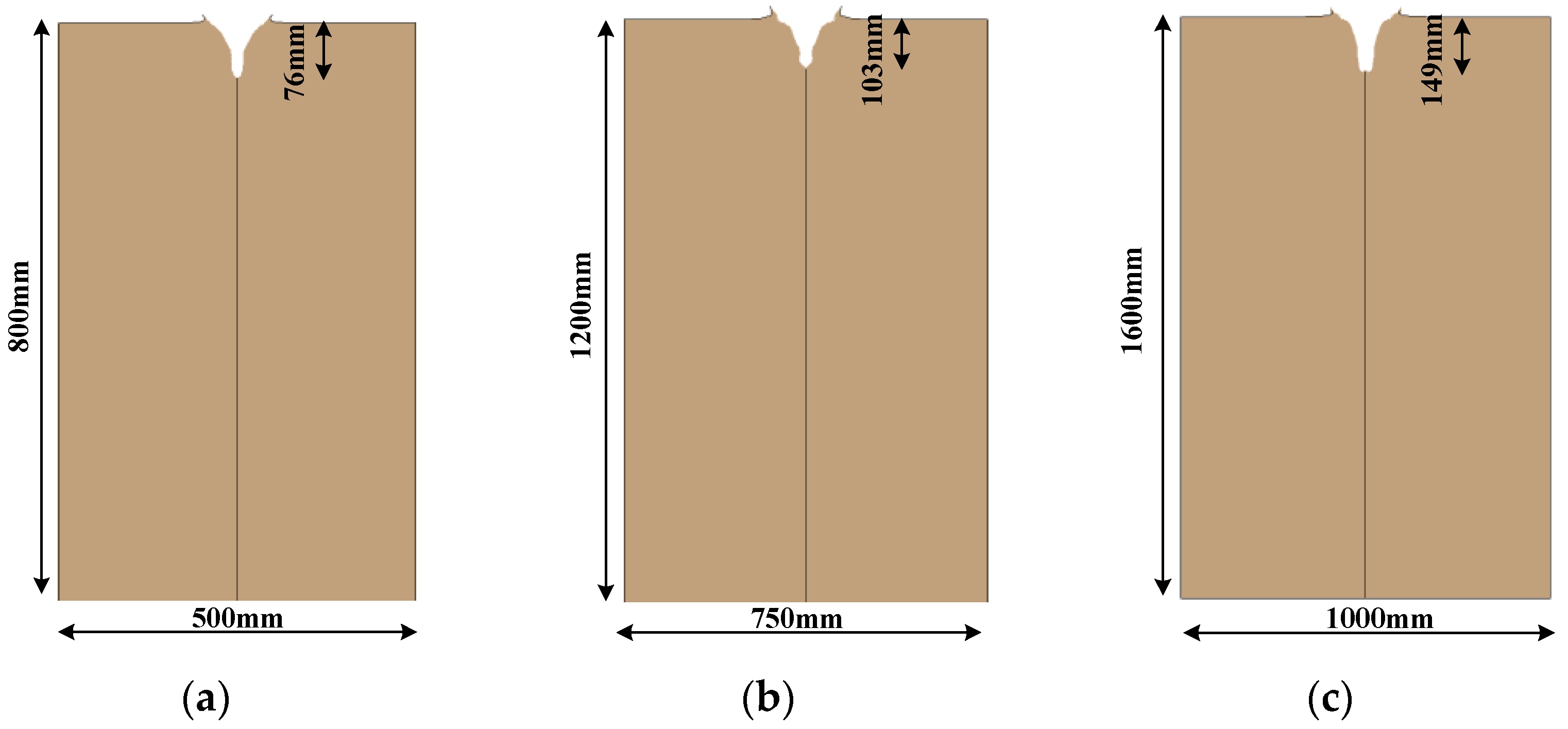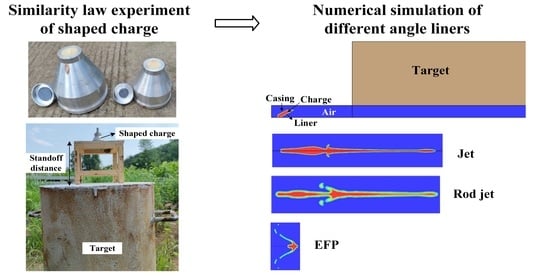1. Introduction
Shaped charge technology is widely used in tandem combatants and torpedoes against military targets [
1,
2], e.g., airport runways, underground bunkers, and ships, as well as civilian targets, e.g., industrial facilities for oil and gas extraction. For a variety of charge types, this paper focuses on the penetration effect of truncated conical charges of shaped charges on concrete-like materials.
As for the theoretical studies on shaped-charge penetration, Brikhoff et al. [
3] proposed a constant velocity jet theory by simplifying the jet velocity and length to constants and assuming that the target is in a pure fluid state during the jet penetration of the target, which allows the strength of the target and metal jet to be neglected. Subsequently, Allison and Vitali [
4] experimentally measured the existence of velocity gradients in the velocity direction of the shaped charge jet and proposed a nonuniform velocity jet theory based on the experimental results, which assumed that all jet microelements were emitted from a virtual source, and the velocity of microelements remained constant and linearly distributed. When the above models are utilized to calculate the jet penetration depth, the classical fluid dynamics formulas are adopted; i.e., the target strength is not considered. Tate [
5] and Alekseevskii [
6] studied the penetration effect of high-speed long rod projectiles regarding the high-speed long rod projectiles as fluid, with the strength effects of targets and projectiles under consideration at the same time, and proposed a hydrodynamic correction model, namely, the “A-T” model. There are different opinions on the effect of concrete strength on the depth of penetration by shaped-charge jets, though the concrete target strength has an obvious impact on the radial expansion of the jet; thus, the calculation of the concrete target resistance is directly related to the accuracy of the concrete target model for the penetration by shaped-charge jets. Tate [
7] and Sternberg [
8] considered that the target strength parameter is the cavity expansion pressure or target resistance under quasistatic conditions. Forrestal and Longcope [
9] and Satapathy and Bless [
10] used static spherical cavity expansion theory to solve the target resistance parameters of brittle materials, e.g., ceramic target materials. Based on the compressible model of jet penetration and combined with the Szendrei–Held expansion equation, Li and Chen [
11] derived the expansion equation of the shaped-charge jet considering the compressibility of the bullet/target material. The model analysis showed that the jet radius, pressure at stagnation point, target strength, target density at stagnation point, and the shaped-charge jet velocity were the main factors affecting the jet reaming.
For experimental and numerical simulation studies, Murphy et al. [
12,
13] conducted experimental studies on the penetration of 20 MPa concrete, granite, and high-strength concrete with shaped charges and concluded that the jet energy was linearly related to the volume of the open pit and verified the equation of state (EOS) that can describe the porosity of granite. Huerta et al. [
14] designed a 0.7 m diameter liner and conducted field tests on the penetration of tuff with shaped charges. Resnyansky and Weckert [
15] conducted tests of shaped charges penetrating/perforating concrete target slabs, in which the shaped charges were divided into three structures with no, simple, or complex waveform adjusters, and the targets were divided into normal strength concrete (NSC, 40 MPa) and ultra-high-performance concrete (UHPC, 200 MPa). The results show that an effective waveform adjuster can significantly improve the performance of the shaped-charge jet; without a waveform adjuster, the depths of shaped charges penetrating into the two targets were 177 and 138 cm, respectively, with a reduction in depth of about 22%, which indicates that high-performance concrete has better performance compared with ordinary concrete. Wang et al. [
16] conducted a systematic experimental study on the penetration of concrete with shaped charges and concluded that the penetration depth of shaped charges and the diameters of craters are quadratically related to the jet velocity. Elshenawy et al. [
17] conducted an experimental study on the effect of perimeter pressure on jet penetration of concrete and introduced the target strength and perimeter pressure into the Allison–Vitalli equation, and the modified equation could predict the depth of jet penetration into the concrete target more accurately.
Ma et al. [
18] carried out experiments on the penetration of shaped charges into a target in the presence of a magnetic field and found that the jet was easy to break and less stable at higher blast heights, while the magnetic field improved the stability of the jet and increased the depth of penetration of the shaped charge into a steel target. The depth of penetration by a 56 mm caliber shaped-charge structure increased by 77%, 72%, and 75% at blast heights of 490, 650, and 800 mm, respectively.
Zhang et al. [
19] designed a new shaped-charge structure consisting of an internal copper liner and an external reactive liner, where the reactive liner was cold-pressed from polytetrafluoroethylene/aluminum powder. The tests showed that compared with the simple copper liner structure, the diameter of the crater and the spalling area of the new polytetrafluoroethylene charge structure penetrating the concrete target were increased to 2–4 times those of the original one. Moreover, as the reactive liner had an explosive effect, the new polytetrafluoroethylene charge structure could create a larger overpressure in the concrete-enclosed space.
Ma et al. [
20] parametrically studied the formation of the shaped-charge jetby varying the number of detonation points, the length of the shell platform, the radius of the curvature, and the thickness of the liner in dynamics analysis software LS-DYNA. The relationship model between the parameters of jet formation and the structural parameters of the shaped charge was established, and the multi-objective optimal design of the shaped-charge structure could be carried out based on this model. Meanwhile, it was found that the velocity, aspect ratio, and kinetic energy of the shaped-charge jet were closely related to the structural parameters of the shaped charge, and the penetration performance of the optimized shaped charge was greatly improved.
Zhang et al. [
21] studied the penetration characteristics of copper, iron, titanium, and aluminum material jets on high-strength concrete and carried out the simulation on the forming process of copper, iron, titanium, and aluminum material jets and the test of penetrating high-strength concrete targets. They found that the penetration depth of copper, iron, and titanium jets basically obeyed the density law; i.e., the penetration depth gradually decreased with decreasing density, and the penetration depth of aluminum jets was slightly greater than that of titanium jets; among them, the titanium jets had the largest jet diameter, crater volume, and the highest opening efficiency.
In the design of the product of the polygonal charge combatant, in order to shorten the development cycle of the new product, during the research, finalization, production and improvement of the new product, a reduced-scale model bomb can be designed first based on the tactical technical index requirements of the newly designed polygonal charge combatant; the model bomb can be used for model testing and improvement until satisfactory performance is obtained; and then the prototype bomb design can be carried out [
3]. Huang and Chen [
22] carried out tests of two EFPs satisfying similar conditions to penetrate a steel target with a simulation ratio of 1.33. According to the radiographs, the projectile shapes of the model and prototype projectiles were similar at relative moments, the head velocities and length-to-thin ratios were similar, and the penetration depths followed the simulation similarity law criterion. Tang and Bai [
23] designed a prototype bullet with 60 mm caliber charge and a simulated bullet with 80 mm caliber charge. The conditions of the intrusion similarity law were satisfied by the prototype and the simulated bullet, and it was found that the intrusion depth of the simulated bullet and the prototype on the steel target satisfied the simulated ratio, i.e., the EFP intrusion similarity law was established. Li et al. [
24] used a three-dimensional numerical simulation to simulate the process of penetration of a set of concentrated-energy jets into steel plates with a simulation ratio of 1.5, and the simulation results showed that the similarity law held. There is a lack of research on the similarity law for the penetration of concrete targets by shaped charges, mostly by means of numerical simulations and less by means of experiments.
In this paper, we carry out tests on the penetration of concrete targets with different sizes of shaped charges conforming to the similarity law and simulate the tests using LS-DYNA finite element (FE) software. By comparing the penetration depths of tests and numerical simulations, we verify the accuracy of the ALE algorithm, fluid–solid coupling algorithm, material model, EOS, and corresponding material parameters. Numerical simulations are further carried out for different types of shaped-charge intruders (jets, rod jets, and EFP) formed by different angles of the drug-type cover to intrude into the concrete target, and the similar laws of different types of shaped-charge intruders in the concrete target are analyzed. The work of this paper shows that the shaped-charge jet penetrating concrete meets the similarity law, so the research on the damage effect of the shaped-charge jet penetrating concrete and the structural design of the shaped charge can be carried out on the basis of smaller model bombs. The conclusions are further extended to prototype bombs.
2. Test Setups
A typical shaped-charge structure [
3] consists of an initiator, explosive, liner, and casing, as shown in
Figure 1a. The distance from the bottom of the charge to the target is denoted as the blast height. When the initiator detonates the explosive, the liner is crushed by the huge explosive energy. The liner material moves outward along the direction which is near-vertical to the charge surface, converging in the axis direction, and forms a high-speed high-temperature metal penetration intruder. When the high-speed metal jets penetrate the target, the impact pressure acting on the target is usually extremely high (over 10 GPa), much greater than the yield strength of the target material. Therefore, the strength of the target at this stage is negligible, and the target can be treated as fluid. As the infiltration speed decreases, the target strength gradually shows its effect, causing the jet infiltration as the hole expansion capacity decreases rapidly, and it terminates the penetration when the jet energy cannot overcome the target resistance. The moment that the intruder impacts the surface of the concrete target, compression waves are generated at the contact location, and it propagates into the intruder and target, respectively. When the stress wave inside the target propagates to the surface, reflection occurs and a tensile wave is generated. Due to the low tensile strength of the concrete, the surface cratering occurs under the strong action of the tensile wave. The schematic diagram of the shaped charge penetrating the concrete target is shown in
Figure 1b.
This test is designed to study whether the process of shaped charges penetrating a concrete target meets the similarity law. Thus, two types of shaped-charge structures with proportional changes in size are designed, which are denoted as small and medium shaped charges, as shown in
Figure 2. With the cone angle of 60°, the charge diameters are set to 50 and 75 mm, and the thickness of the liners are 1 and 1.5 mm, respectively (the detail sizes for the two types of charges are in the ratio of 1:1.5).
Figure 3a shows the photo of the structure of the shaped charge filled with B explosive (RDX:TNT = 6:4); the material of the liner is high conductivity oxygen-free copper, and the material of the casing is aviation aluminum. The concrete target is in the shape of a cylinder, and the material is C40 concrete. Two shots of test were conducted (one shot for each of the small- and medium-size shaped-charge structures), with the bomb height and target size scaled according to the proportion, and the test scenarios and the test layout are shown in
Table 1 and
Figure 3b, respectively. According to the similarity theory [
3], the main parameters that affect the shaped-charge jet include the characteristic parameters of the shaped charge (including the explosive, casing, and liner), the target, and the relative dislocation of the bullet and target, i.e., the blast height. For the structure of the shaped charge to meet the similarity law in the process of jet formation and penetration, the jet head velocity must be equal, and the depth of penetrating the target must be proportional to the diameter of the charge. Hence, it can be concluded that the test of penetrating the concrete target with the shaped charge in this paper meets the similarity law.
4. Influence of the Liner Angle
Shaped-charge jets are greatly influenced by the shaped-charge structure, which can usually be divided into three types, i.e., slender jet with a significant velocity gradient (JET), rod jet with a small velocity gradient (Jetting Projectile Charge, JPC), and explosively formed projectile with almost no velocity gradient (EFP, also known as self-forging fragment). The liner angles for these three types of shaped-charge jets are <70°, 70° to 140°, and 140° to 160°, respectively [
25]. In this section, we study the similarity laws of different types of shaped-charge jets penetrating concrete targets and design two additional truncated cone-shaped liner with different angles of 90° and 150° based on the shaped-charge structure in the test. The diameters of the three shaped charges in this section are 50, 75 and 100 mm, respectively (the dimensions of the medium and large shaped-charge structures are 1.5 and 2 times those of the small one).
Figure 9 gives the diagrams of small shaped charges with liner angles of 90° and 150°, and the extended scenarios are listed in
Table 6.
The jet formed by the shaped-charge structures with three liner angles in this paper is shown in
Figure 9. JET includes slug and jet, of which the slug has large mass and low velocity (below 1 km/s) and basically no intrusion capability, while the jet part has small mass, high head velocity (about 5 km/s), and a large velocity gradient, which shows excellent intrusion performance. EFP has a shape similar to a metal disc, with a velocity of about 3 km/s and basically no velocity gradient. The jet formed by JPC has a large aspect ratio, a certain velocity gradient, and a head velocity of 4 km/s. The head velocity of JET and JPC formed by small, medium, and large shaped charges are basically the same, as well as the velocity of EFP, which indicates that the formation process of a shaped-charge jet is in accordance with the similarity law.
Figure 10,
Figure 11,
Figure 12 and
Figure 13 show the numerical simulation results of the small, medium, and large shaped-charge structures penetrating the concrete target with the liner angles of 60°, 90° and 150°, and it is found that the depth of the small, medium, and large shaped-charge structures penetrating the concrete target has a deviation of less than 12% to the similarity law, which is within the acceptable range of engineering; i.e., the process of the shaped charges penetrating the concrete target meets the similarity law. Additionally, the penetrating effect of various types of shaped-charge jets on the concrete target is different; the greater the liner angle, the higher jet velocity and the greater penetrating depth. Hence, the penetrating depth on the concrete target follows the relationship: JET > JPC > EFP. The greater the liner angle, the greater the jet diameter and the larger the crater diameter; thus, the concrete target crater area follows the relationship: EFP > JPC > JET.
5. Conclusions
In this paper, the damage effect and similarity law of a concrete target penetrated by shaped charges are studied through experiments and numerical simulation. The similarity law test for the penetration of the concrete target by the shaped-charge jets was carried out first. LS-DYNA FE software was used to reproduce the test, and the accuracy of ALE algorithm, fluid–solid coupling algorithm, material model, EOS, and corresponding material parameters was verified by comparing the penetration depths of test data and numerical simulation results. Further research on the similarity law of different types of jets (JET, JPC, and EFP) formed by shaped charges with different liner angles penetrating concrete targets was conducted. The main conclusions are:
(1) The penetration depth of the concrete target meets the similarity law under the ratio of 1:1.5 for the size of the shaped-charge structure, the target, and the burst height.
(2) The formation process of the shaped-charge jets and the depth of penetration into concrete targets meet the similarity law. It is feasible to complete the design by using a model projectile of similar conditions and then extend it to the prototype projectile.
(3) Different types of penetrators have different penetration effects on the concrete target; the larger the liner angle, the higher the jet velocity and the greater the penetrating depth of the concrete target, with the relationship of JET > JPC > EFP. The larger the liner angle, the larger the jet diameter and the larger the crater diameter, with the relationship of EFP > JPC > JET.
